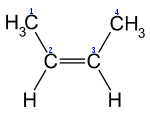- 2-Butene
-
2-Butene 

 But-2-eneOther namesβ-Butylene
But-2-eneOther namesβ-ButyleneIdentifiers CAS number 107-01-7 
ChemSpider 11719 
UNII S1SK37516R 
EC-number 203-452-9 ChEBI CHEBI:48363 
RTECS number EM2932000 Jmol-3D images Image 1 - C(=CC)C
Properties Molecular formula C4H8 Molar mass 56.106 g/mol Melting point -139°C
Boiling point 4 °C, 277 K, 39 °F
Hazards[1] GHS pictograms  Template:GHS04
Template:GHS04GHS signal word DANGER GHS hazard statements H220 GHS precautionary statements P210, P377, P381, P403 EU Index 601-012-00-4 EU classification Extremely flammable (F+) R-phrases R12 S-phrases (S2) S9 S16 S33 NFPA 704 Flash point flammable gas Autoignition
temperature324 °C (615 °F) Related compounds Related butenes 1-Butene
cis-2-Butene
trans-2-Butene
IsobuteneRelated compounds Butane
Butyne (verify) (what is:
(verify) (what is:  /
/ ?)
?)
Except where noted otherwise, data are given for materials in their standard state (at 25 °C, 100 kPa)Infobox references 2-Butene is an acyclic alkene with four carbon atoms. It is the simplest alkene exhibiting cis/trans-isomerism (also known as (E/Z)-isomerism); that is, it exists as two geometrical isomers cis-2-butene ((Z)-2-butene), shown at the right, and trans-2-butene ((E)-2-butene), not shown.
It is a petrochemical, produced by the catalytic cracking of crude oil. Its main uses are in the production of gasoline (petrol) and butadiene,[2] although some 2-butene is also used to produce the solvent butanone via hydration to 2-butanol followed by oxidation.
The two isomers are extremely difficult to separate by distillation because of the proximity of their boiling points (4 °C for cis and 1 °C for trans[3]). The more elongated trans-molecule which has a tougher job to get its tail free from the liquid has the higher boiling point, the more rounded cis isomer escapes easier, thus having a lower boiling point. However, separation is unnecessary in most industrial settings, as both isomers behave similarly in most of the desired reactions. A typical industrial 2-butene mixture is 70% (Z)-2-butene (cis-isomer) and 30% (E)-2-butene (trans-isomer). Butane and 1-butene are common impurities, present at 1% or more in industrial mixtures, which also contain smaller amounts of isobutene, butadiene and butyne.[2]
References
- ^ cis-2-Butene, International Chemical Safety Card 0397, Geneva: International Programme on Chemical Safety, March 1996, http://www.inchem.org/documents/icsc/icsc/eics0397.htm. trans-2-Butene, International Chemical Safety Card 0398, Geneva: International Programme on Chemical Safety, March 1996, http://www.inchem.org/documents/icsc/icsc/eics0398.htm.
- ^ a b 2-Butene, SIDS Initial Assessment Report, Geneva: United Nations Environment Programme, February 1995, http://www.inchem.org/documents/sids/sids/107017.pdf.
- ^ Chemical Safety Information from Intergovernmental Organizations
External links
- SIDS Initial Assessment Report for 2-Butene from the Organisation for Economic Co-operation and Development (OECD)

This article about a hydrocarbon is a stub. You can help Wikipedia by expanding it.

